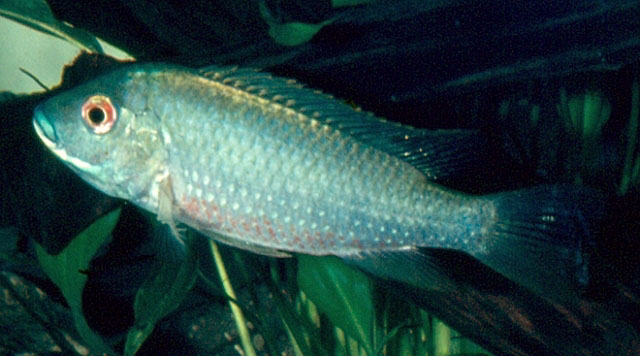|
Dorsal spines (total): 14-16; Dorsal soft rays (total): 11-12; Anal spines: 3-3; Anal soft rays: 8-9. Diagnosis: Coptodon deckerti differs from its congeners except for a few members of the genus Coptodon in quadricuspid posterior pharyngeal teeth on lower pharyngeal jaw, a character shared only with Coptodon tholloni, C. cameronensis, C. dageti, C. congica, C. ejagham, and C. nigrans (Ref. 85854). It differs from C. cameronensis and C. dageti in lower length of dorsal fin base, 50.6-54.7% of standard length vs. 57.2-65.0%; from C. tholloni in higher predorsal distance, 41.2-46.1% of standard length vs. 35.6-40.7%; from C. congica in lower body depth, 36.0-40.0% of standard length vs. 41.5-49.2%; from C. kottae in narrower interorbital width, 9.4-12.2% of standard length vs. 12.4-14.0%; and from C. ismailiaensis in longer lower jaw length, 13.8-16.5% of standard length vs. 11.8-12.0% (Ref. 85854). Differences to C. nigrans are based on a combination of morphometric, life history, genetic and ecological data, i.e. a shorter snout length, 12.7-15.6% of standard length vs. 15.8-18.2%, by breeding exclusively in the shallow water above 2 m water depth vs. excavated caves below 5 m depth, largest reproductively active C. deckerti specimen are smaller than smallest reproductively active specimens of C. nigrans, 60.2-102.2 mm standard length vs. 105.5-151.5 mm (Ref. 85854). It differs from C. ejagham in larger eye length, 8.5-10.7% of standard length vs. 6.2-8.4% (Ref. 85854).
Description: It is a medium-sized tilapia with a laterally compressed body (Ref. 85854). Large and compact head, head profile slightly concave; snout outline obtuse; eye large and interorbital width always greater than eye length (Ref. 85854). Greatest body depth at level of first dorsal spine; dorsal line slightly posteroventrally curved; caudal peduncle about as long as deep or slightly longer (Ref. 85854). Body scales cycloid, scales on chest smaller than flank scales and deeply embedded; upper lateral line extending from posterior margin of gill cover to approximately last dorsal ray; upper lateral line separated from first dorsal spine by two to three scale rows; lower lateral line originating at level of first dorsal branched rays and terminating midlaterally on caudal peduncle; on or two scales of lower lateral line extending onto caudal fin; two scale rows between upper and lower lateral line; preoperculum with three to four regular rows; lower one third of pectoral base mostly scaled (Ref. 85854). First ceratobranchial with 8-10 gill rakers and first upper gill-arch with 3-5 gill rakers; ceratobranchial rakers stout, broader on base, pointed; gill raker in angle of arch and firt four epibranchial rakers more slender, decreasing in size towards last (Ref. 85854). Origin of dorsal fin at level of origin of pelvic fin; first dorsal spine always shortest, last dorsal spine always longest; longest spines always shorter than longest ray; last dorsal ray most deeply branched; caudal fin outline truncate; anal fin with 3 spines, third anal spine always longest; tip of longest anal fin ray overlapping hypuralia; last dorsal ray most deeply branched; tip of longest pelvic-fin ray in most specimens reaching anus, in rare cases terminating slightly before anus (Ref. 81260, 85854). Jaws isognathous; teeth in upper and lower outer row in both jaws bicuspid; neck of anterior jaw teeth stout, crown expanded and cusps truncated; one to three incomplete inner rows of smaller tricuspid teeth in both jaws; lower pharyngeal jaw as long as broad, anterior keel shorter than toothed area; posterior pheryngeal teeth quadricuspid, stout, sligtly hooked and regularly arranged, especially over posterior third of toothed area; dentigerous plate triangular; most of teeth in anterior two thirds of toothed area approach the 'kukri' tooth shape (Ref. 81260, 85854).
Colouration: Colouration in alcohol: basic colouration brownish; dorsal side dark brownish, ventral side light brownish; flank scales with dark scale margins and a light centre on scales below lateral line, not always present; lower lip light brownish to whitish, upper lip darker; lower side of head completely black; chest and lower side of head blackish or with blackish areas, sometimes extending onto light coloured belly; seven to eight dark vertical bars on dorsum and sides, first bar at level of first dorsal spine, last two on caudal peduncle, and a nape band; second vertical bar deeply bifurcated; vertical bars sometimes not present; no longitudinal mid-lateral band; dark broad lachrymal stripe extending from lachrymal to jaw angle; dark opercular spot; pectoral fins transparent; pelvic fins blackish; anal fin dark brownish, margins transparent; caudal fin either dark brownish and margins transparent or lower part dark brownish with light dots in the upper part; dorsal fin dark brownish, margins transparent, 'tilapia spot' always visible, with some light dots in soft part behind 'tilapia spot' (Ref. 85854). Colouration in life: basic colouration silvery-bluish to brown-greyish, chest and belly blackish-red, dorsum yellow-greenish to bright yellow in courting individuals; lower half of head completely black, upper half of head yellow-greenish; upper lip light bluish and lower lip whitish; a horizontal iridescent blue line above antero-rostral margin of preopercle; iris bright red; apparently depending on motivational state, i.e. during parental care, body with seven to eight black dark vertical bars, nape band, supraorbital and interorbital stripe; second vertical bar always deeply bifurcated; dark broad lachrymal stripe extending from lachrymal to jaw angle; dark opercular spot; pectoral fins transparent, pelvic fins and anal fin with black tips; dorsal fin yellow edged, 'tilapia spot' well visible, sometimes light dots in soft part of dorsal fin behind 'tilapia spot'; caudal fin either completely greyish or upper half pale with few yellow dots and lower half blackish (Ref. 81260, 85854). |

